NISSAN TERRANO 2002 Service Repair Manual
Manufacturer: NISSAN, Model Year: 2002, Model line: TERRANO, Model: NISSAN TERRANO 2002Pages: 1767, PDF Size: 41.51 MB
Page 1621 of 1767
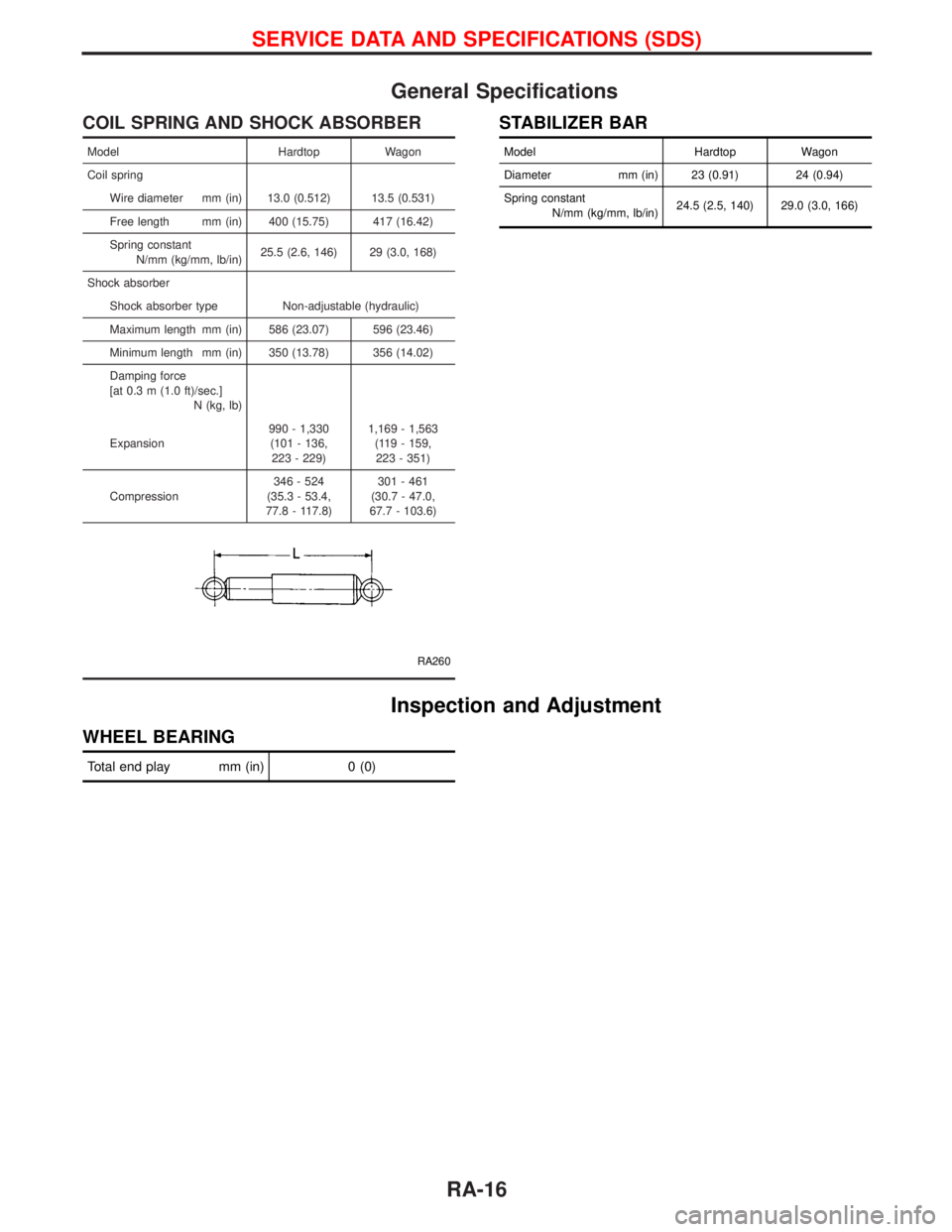
General Specifications
COIL SPRING AND SHOCK ABSORBER
Model Hardtop Wagon
Coil spring
Wire diameter mm (in) 13.0 (0.512) 13.5 (0.531)
Free length mm (in) 400 (15.75) 417 (16.42)
Spring constant
N/mm (kg/mm, lb/in)25.5 (2.6, 146) 29 (3.0, 168)
Shock absorber
Shock absorber type Non-adjustable (hydraulic)
Maximum length mm (in) 586 (23.07) 596 (23.46)
Minimum length mm (in) 350 (13.78) 356 (14.02)
Damping force
[at 0.3 m (1.0 ft)/sec.]
N (kg, lb)
Expansion990 - 1,330
(101 - 136,
223 - 229)1,169 - 1,563
(119 - 159,
223 - 351)
Compression346 - 524
(35.3 - 53.4,
77.8 - 117.8)301 - 461
(30.7 - 47.0,
67.7 - 103.6)
RA260
STABILIZER BAR
Model Hardtop Wagon
Diameter mm (in) 23 (0.91) 24 (0.94)
Spring constant
N/mm (kg/mm, lb/in)24.5 (2.5, 140) 29.0 (3.0, 166)
Inspection and Adjustment
WHEEL BEARING
Total end play mm (in) 0 (0)
SERVICE DATA AND SPECIFICATIONS (SDS)
RA-16
Page 1622 of 1767
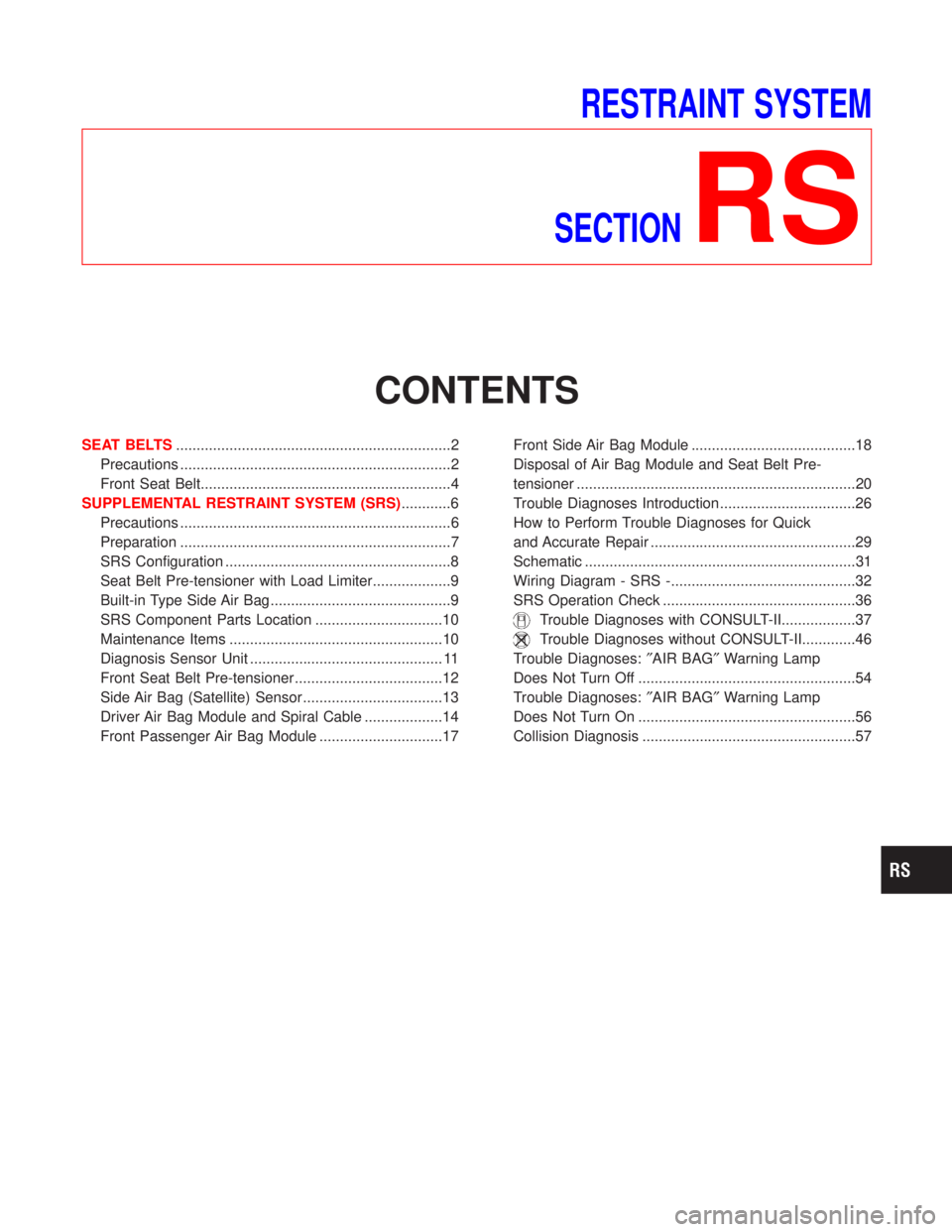
RESTRAINT SYSTEM
SECTION
RS
CONTENTS
SEAT BELTS...................................................................2
Precautions ..................................................................2
Front Seat Belt.............................................................4
SUPPLEMENTAL RESTRAINT SYSTEM (SRS)............6
Precautions ..................................................................6
Preparation ..................................................................7
SRS Configuration .......................................................8
Seat Belt Pre-tensioner with Load Limiter...................9
Built-in Type Side Air Bag............................................9
SRS Component Parts Location ...............................10
Maintenance Items ....................................................10
Diagnosis Sensor Unit ............................................... 11
Front Seat Belt Pre-tensioner ....................................12
Side Air Bag (Satellite) Sensor ..................................13
Driver Air Bag Module and Spiral Cable ...................14
Front Passenger Air Bag Module ..............................17Front Side Air Bag Module ........................................18
Disposal of Air Bag Module and Seat Belt Pre-
tensioner ....................................................................20
Trouble Diagnoses Introduction.................................26
How to Perform Trouble Diagnoses for Quick
and Accurate Repair ..................................................29
Schematic ..................................................................31
Wiring Diagram - SRS -.............................................32
SRS Operation Check ...............................................36
Trouble Diagnoses with CONSULT-II..................37
Trouble Diagnoses without CONSULT-II.............46
Trouble Diagnoses:²AIR BAG²Warning Lamp
Does Not Turn Off .....................................................54
Trouble Diagnoses:²AIR BAG²Warning Lamp
Does Not Turn On .....................................................56
Collision Diagnosis ....................................................57
Page 1623 of 1767
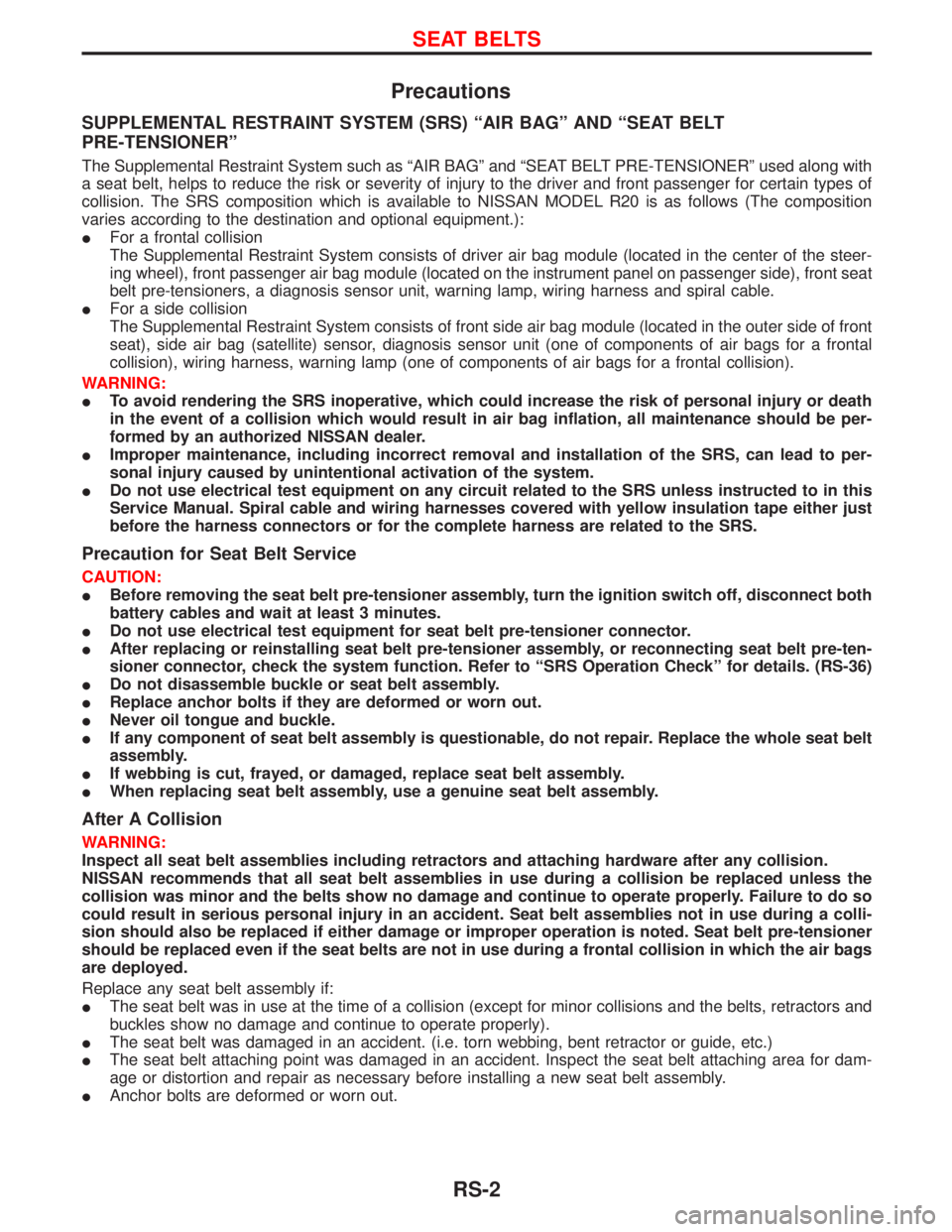
Precautions
SUPPLEMENTAL RESTRAINT SYSTEM (SRS) ªAIR BAGº AND ªSEAT BELT
PRE-TENSIONERº
The Supplemental Restraint System such as ªAIR BAGº and ªSEAT BELT PRE-TENSIONERº used along with
a seat belt, helps to reduce the risk or severity of injury to the driver and front passenger for certain types of
collision. The SRS composition which is available to NISSAN MODEL R20 is as follows (The composition
varies according to the destination and optional equipment.):
IFor a frontal collision
The Supplemental Restraint System consists of driver air bag module (located in the center of the steer-
ing wheel), front passenger air bag module (located on the instrument panel on passenger side), front seat
belt pre-tensioners, a diagnosis sensor unit, warning lamp, wiring harness and spiral cable.
IFor a side collision
The Supplemental Restraint System consists of front side air bag module (located in the outer side of front
seat), side air bag (satellite) sensor, diagnosis sensor unit (one of components of air bags for a frontal
collision), wiring harness, warning lamp (one of components of air bags for a frontal collision).
WARNING:
ITo avoid rendering the SRS inoperative, which could increase the risk of personal injury or death
in the event of a collision which would result in air bag inflation, all maintenance should be per-
formed by an authorized NISSAN dealer.
IImproper maintenance, including incorrect removal and installation of the SRS, can lead to per-
sonal injury caused by unintentional activation of the system.
IDo not use electrical test equipment on any circuit related to the SRS unless instructed to in this
Service Manual. Spiral cable and wiring harnesses covered with yellow insulation tape either just
before the harness connectors or for the complete harness are related to the SRS.
Precaution for Seat Belt Service
CAUTION:
IBefore removing the seat belt pre-tensioner assembly, turn the ignition switch off, disconnect both
battery cables and wait at least 3 minutes.
IDo not use electrical test equipment for seat belt pre-tensioner connector.
IAfter replacing or reinstalling seat belt pre-tensioner assembly, or reconnecting seat belt pre-ten-
sioner connector, check the system function. Refer to ªSRS Operation Checkº for details. (RS-36)
IDo not disassemble buckle or seat belt assembly.
IReplace anchor bolts if they are deformed or worn out.
INever oil tongue and buckle.
IIf any component of seat belt assembly is questionable, do not repair. Replace the whole seat belt
assembly.
IIf webbing is cut, frayed, or damaged, replace seat belt assembly.
IWhen replacing seat belt assembly, use a genuine seat belt assembly.
After A Collision
WARNING:
Inspect all seat belt assemblies including retractors and attaching hardware after any collision.
NISSAN recommends that all seat belt assemblies in use during a collision be replaced unless the
collision was minor and the belts show no damage and continue to operate properly. Failure to do so
could result in serious personal injury in an accident. Seat belt assemblies not in use during a colli-
sion should also be replaced if either damage or improper operation is noted. Seat belt pre-tensioner
should be replaced even if the seat belts are not in use during a frontal collision in which the air bags
are deployed.
Replace any seat belt assembly if:
IThe seat belt was in use at the time of a collision (except for minor collisions and the belts, retractors and
buckles show no damage and continue to operate properly).
IThe seat belt was damaged in an accident. (i.e. torn webbing, bent retractor or guide, etc.)
IThe seat belt attaching point was damaged in an accident. Inspect the seat belt attaching area for dam-
age or distortion and repair as necessary before installing a new seat belt assembly.
IAnchor bolts are deformed or worn out.
SEAT BELTS
RS-2
Page 1624 of 1767

NRS127
SEAT BELTS
Precautions (Cont'd)
RS-3
Page 1625 of 1767
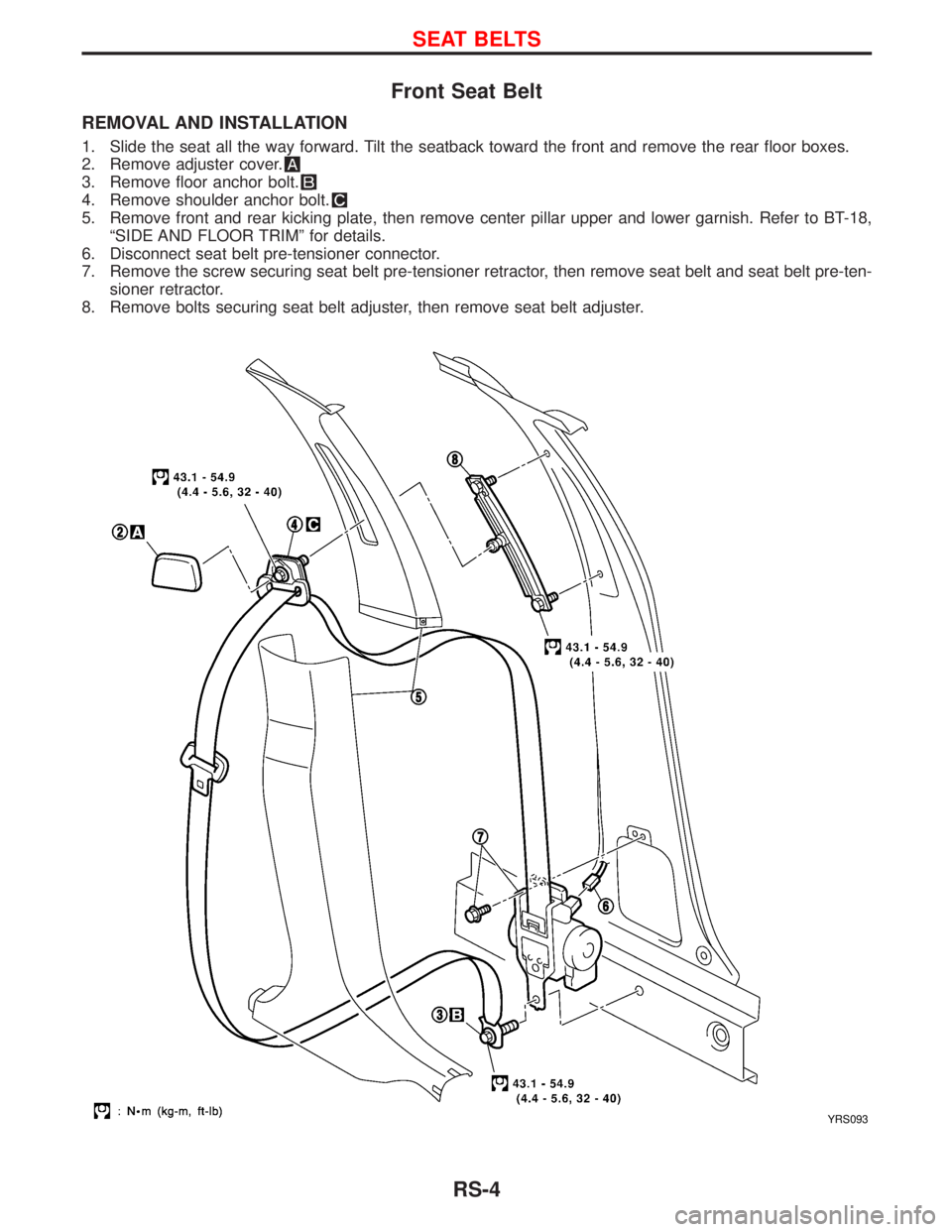
Front Seat Belt
REMOVAL AND INSTALLATION
1. Slide the seat all the way forward. Tilt the seatback toward the front and remove the rear floor boxes.
2. Remove adjuster cover.
3. Remove floor anchor bolt.
4. Remove shoulder anchor bolt.
5. Remove front and rear kicking plate, then remove center pillar upper and lower garnish. Refer to BT-18,
ªSIDE AND FLOOR TRIMº for details.
6. Disconnect seat belt pre-tensioner connector.
7. Remove the screw securing seat belt pre-tensioner retractor, then remove seat belt and seat belt pre-ten-
sioner retractor.
8. Remove bolts securing seat belt adjuster, then remove seat belt adjuster.
YRS093
SEAT BELTS
RS-4
Page 1626 of 1767

YRS074
SEAT BELTS
Front Seat Belt (Cont'd)
RS-5
Page 1627 of 1767
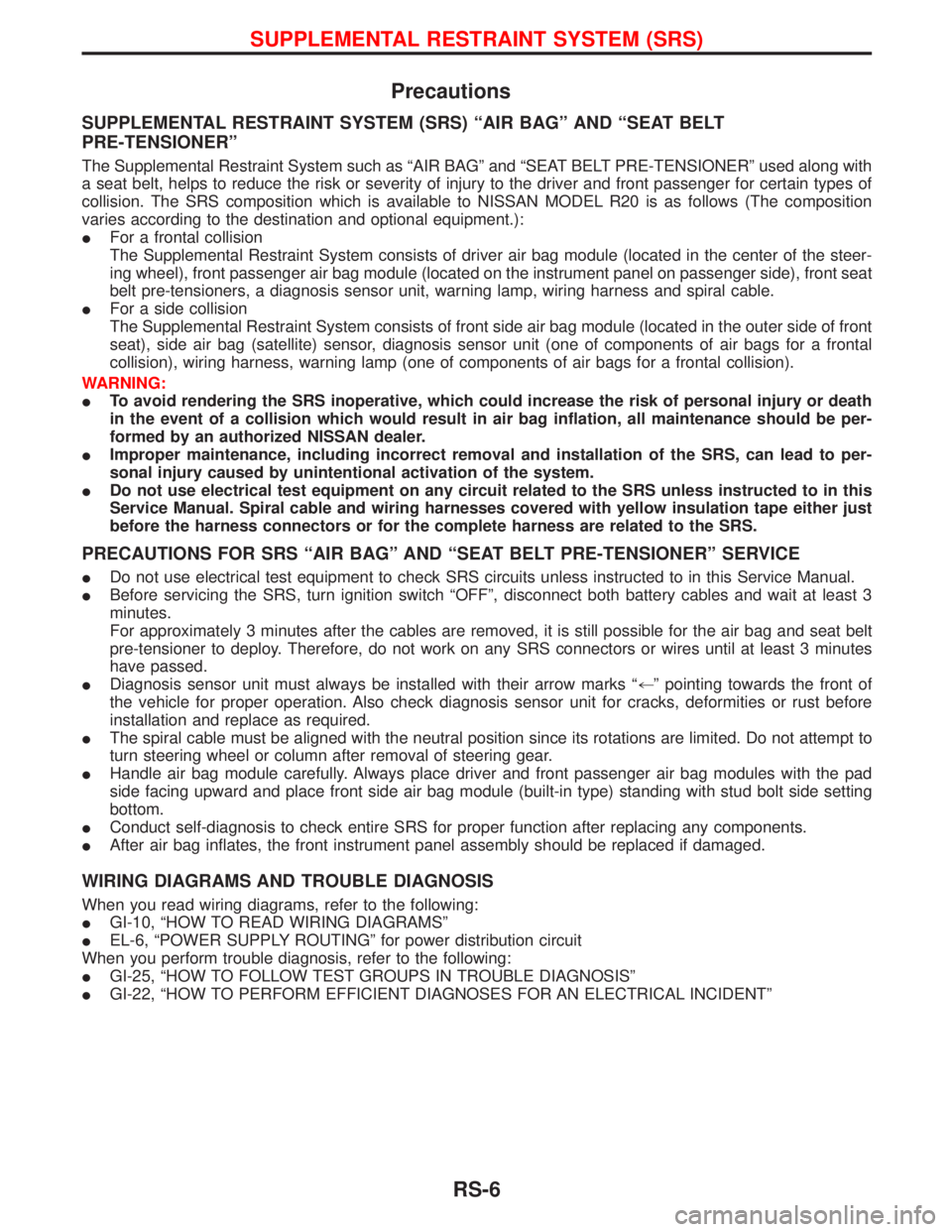
Precautions
SUPPLEMENTAL RESTRAINT SYSTEM (SRS) ªAIR BAGº AND ªSEAT BELT
PRE-TENSIONERº
The Supplemental Restraint System such as ªAIR BAGº and ªSEAT BELT PRE-TENSIONERº used along with
a seat belt, helps to reduce the risk or severity of injury to the driver and front passenger for certain types of
collision. The SRS composition which is available to NISSAN MODEL R20 is as follows (The composition
varies according to the destination and optional equipment.):
IFor a frontal collision
The Supplemental Restraint System consists of driver air bag module (located in the center of the steer-
ing wheel), front passenger air bag module (located on the instrument panel on passenger side), front seat
belt pre-tensioners, a diagnosis sensor unit, warning lamp, wiring harness and spiral cable.
IFor a side collision
The Supplemental Restraint System consists of front side air bag module (located in the outer side of front
seat), side air bag (satellite) sensor, diagnosis sensor unit (one of components of air bags for a frontal
collision), wiring harness, warning lamp (one of components of air bags for a frontal collision).
WARNING:
ITo avoid rendering the SRS inoperative, which could increase the risk of personal injury or death
in the event of a collision which would result in air bag inflation, all maintenance should be per-
formed by an authorized NISSAN dealer.
IImproper maintenance, including incorrect removal and installation of the SRS, can lead to per-
sonal injury caused by unintentional activation of the system.
IDo not use electrical test equipment on any circuit related to the SRS unless instructed to in this
Service Manual. Spiral cable and wiring harnesses covered with yellow insulation tape either just
before the harness connectors or for the complete harness are related to the SRS.
PRECAUTIONS FOR SRS ªAIR BAGº AND ªSEAT BELT PRE-TENSIONERº SERVICE
IDo not use electrical test equipment to check SRS circuits unless instructed to in this Service Manual.
IBefore servicing the SRS, turn ignition switch ªOFFº, disconnect both battery cables and wait at least 3
minutes.
For approximately 3 minutes after the cables are removed, it is still possible for the air bag and seat belt
pre-tensioner to deploy. Therefore, do not work on any SRS connectors or wires until at least 3 minutes
have passed.
IDiagnosis sensor unit must always be installed with their arrow marks ª+º pointing towards the front of
the vehicle for proper operation. Also check diagnosis sensor unit for cracks, deformities or rust before
installation and replace as required.
IThe spiral cable must be aligned with the neutral position since its rotations are limited. Do not attempt to
turn steering wheel or column after removal of steering gear.
IHandle air bag module carefully. Always place driver and front passenger air bag modules with the pad
side facing upward and place front side air bag module (built-in type) standing with stud bolt side setting
bottom.
IConduct self-diagnosis to check entire SRS for proper function after replacing any components.
IAfter air bag inflates, the front instrument panel assembly should be replaced if damaged.
WIRING DIAGRAMS AND TROUBLE DIAGNOSIS
When you read wiring diagrams, refer to the following:
IGI-10, ªHOW TO READ WIRING DIAGRAMSº
IEL-6, ªPOWER SUPPLY ROUTINGº for power distribution circuit
When you perform trouble diagnosis, refer to the following:
IGI-25, ªHOW TO FOLLOW TEST GROUPS IN TROUBLE DIAGNOSISº
IGI-22, ªHOW TO PERFORM EFFICIENT DIAGNOSES FOR AN ELECTRICAL INCIDENTº
SUPPLEMENTAL RESTRAINT SYSTEM (SRS)
RS-6
Page 1628 of 1767
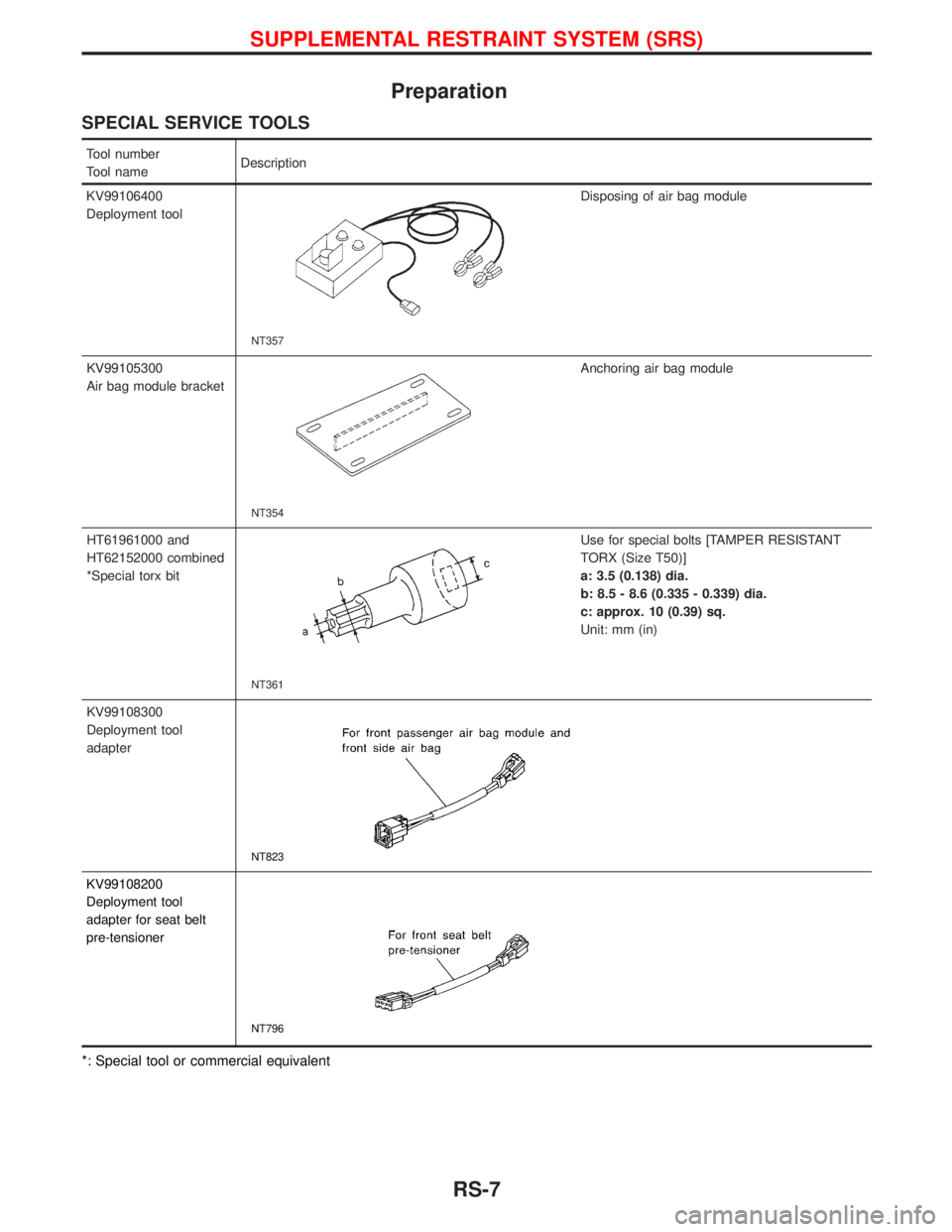
Preparation
SPECIAL SERVICE TOOLS
Tool number
Tool nameDescription
KV99106400
Deployment tool
NT357
Disposing of air bag module
KV99105300
Air bag module bracket
NT354
Anchoring air bag module
HT61961000 and
HT62152000 combined
*Special torx bit
NT361
Use for special bolts [TAMPER RESISTANT
TORX (Size T50)]
a: 3.5 (0.138) dia.
b: 8.5 - 8.6 (0.335 - 0.339) dia.
c: approx. 10 (0.39) sq.
Unit: mm (in)
KV99108300
Deployment tool
adapter
NT823
KV99108200
Deployment tool
adapter for seat belt
pre-tensioner
NT796
*: Special tool or commercial equivalent
SUPPLEMENTAL RESTRAINT SYSTEM (SRS)
RS-7
Page 1629 of 1767
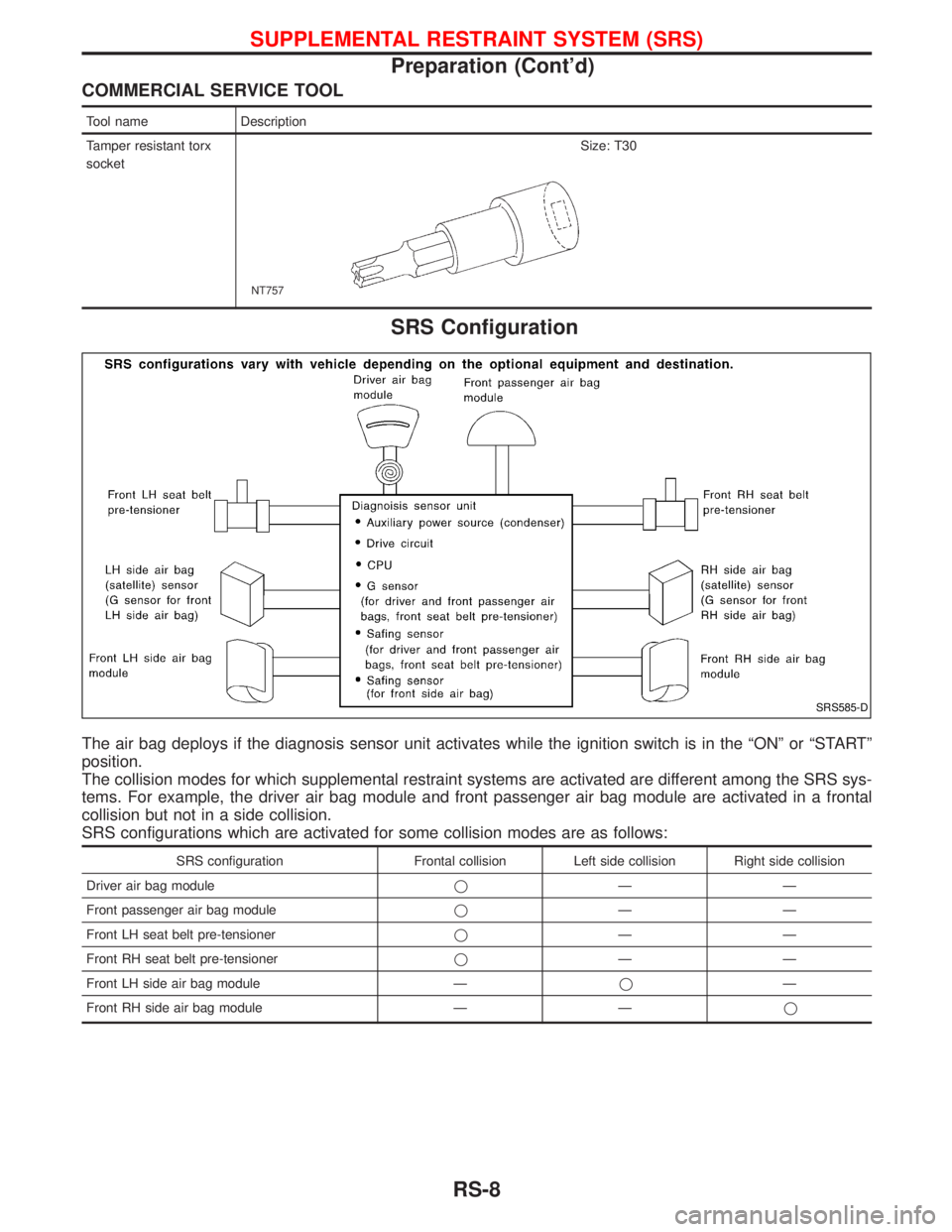
COMMERCIAL SERVICE TOOL
Tool name Description
Tamper resistant torx
socket
NT757
Size: T30
SRS Configuration
The air bag deploys if the diagnosis sensor unit activates while the ignition switch is in the ªONº or ªSTARTº
position.
The collision modes for which supplemental restraint systems are activated are different among the SRS sys-
tems. For example, the driver air bag module and front passenger air bag module are activated in a frontal
collision but not in a side collision.
SRS configurations which are activated for some collision modes are as follows:
SRS configuration Frontal collision Left side collision Right side collision
Driver air bag moduleqÐÐ
Front passenger air bag moduleqÐÐ
Front LH seat belt pre-tensionerqÐÐ
Front RH seat belt pre-tensionerqÐÐ
Front LH side air bag module ÐqÐ
Front RH side air bag module Ð Ðq
SRS585-D
SUPPLEMENTAL RESTRAINT SYSTEM (SRS)
Preparation (Cont'd)
RS-8
Page 1630 of 1767
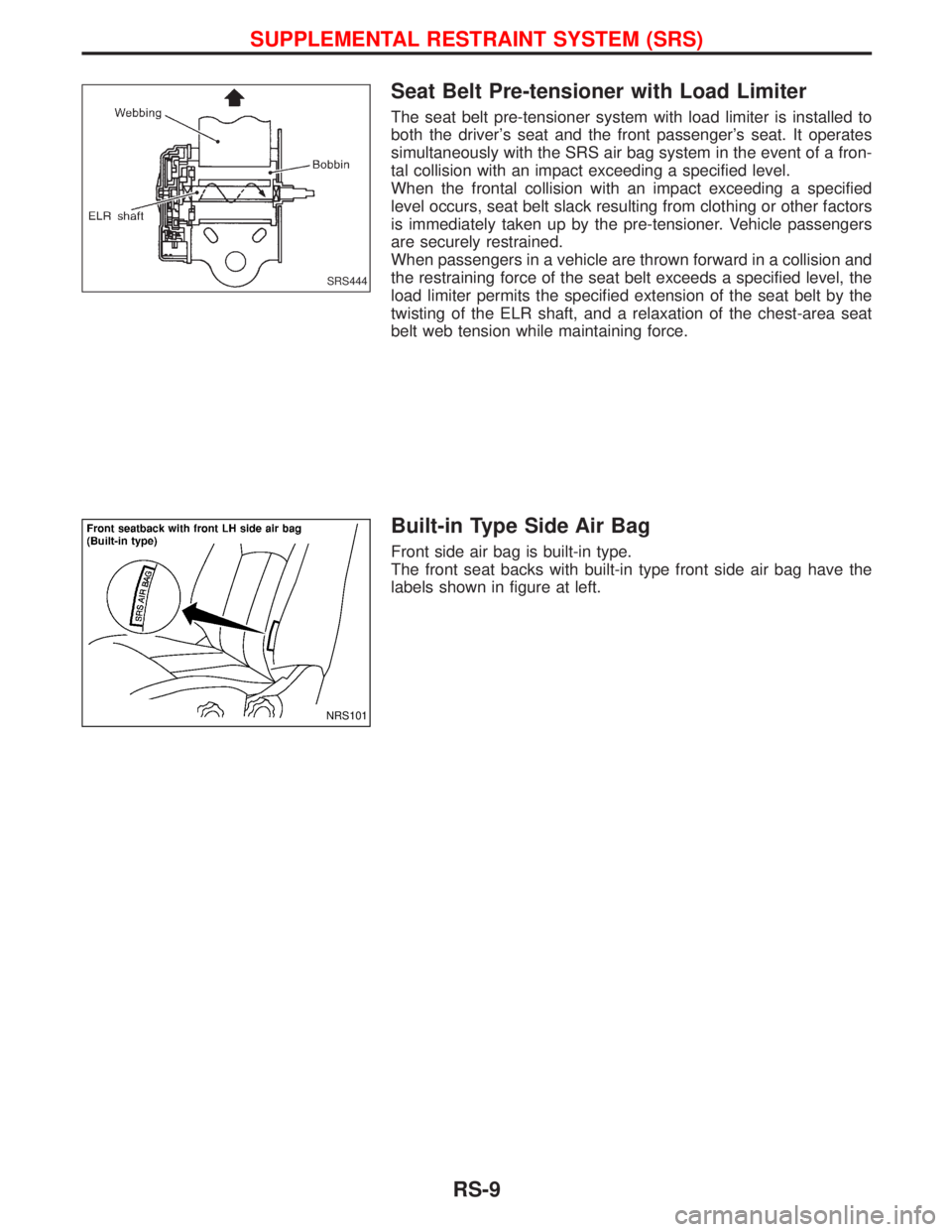
Seat Belt Pre-tensioner with Load Limiter
The seat belt pre-tensioner system with load limiter is installed to
both the driver's seat and the front passenger's seat. It operates
simultaneously with the SRS air bag system in the event of a fron-
tal collision with an impact exceeding a specified level.
When the frontal collision with an impact exceeding a specified
level occurs, seat belt slack resulting from clothing or other factors
is immediately taken up by the pre-tensioner. Vehicle passengers
are securely restrained.
When passengers in a vehicle are thrown forward in a collision and
the restraining force of the seat belt exceeds a specified level, the
load limiter permits the specified extension of the seat belt by the
twisting of the ELR shaft, and a relaxation of the chest-area seat
belt web tension while maintaining force.
Built-in Type Side Air Bag
Front side air bag is built-in type.
The front seat backs with built-in type front side air bag have the
labels shown in figure at left.
SRS444
NRS101
SUPPLEMENTAL RESTRAINT SYSTEM (SRS)
RS-9